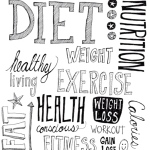I’m sorry I’ve been away from the forum for a while and neglected some topics; a family crisis kept me away, but I’m glad to be back.
I’m wondering how concerned I need to be about having a large waistline in comparison to the rest of me if I’m fairly thin. My waist has always been large compared to my bust (one size larger) and especially my hips (three sizes larger) in terms of standard clothing sizes, even when I was a thin teenager sewing my own clothes. At this point I’ve lost 38 pounds, my BMI is 20.4, and my waist:hip ratio has dropped from 0.92 to 0.86. So even if I lose 14 more pounds and get back to my baseline weight at a BMI of 18.0, I don’t think my waist:hip ratio will get below 0.8, which is supposedly what you want for diabetes prevention, which is something I’m concerned about because of family history. And since my hips are small compared to the rest of me and American clothing sizes have gotten so much larger than they used to be, I will have to either find size 0 jeans in expensive clothing stores (ouch!) or buy my jeans in the children’s department (the colors in the girls department are hideous; the cut of the boys’ jeans is not very flattering; I’ve checked, I can already fit into the largest children’s sizes). Since I wear jeans 7 days a week and they’re most practical for my work, this is a problem. (Sewing one’s own jeans is *not* practical.) Continuing to lose weight past my baseline, below a BMI of 18.0, seems questionable at best for health purposes. Losing even 3 more pounds at that point would put my BMI at 17.5 and still probably not solve the large waist problem.
Can you still be TOFI at a BMI of 18.0 or 17.5? Is the waist:hip ratio thing somewhat arbitrary? What about a bust:waist ratio? Why hips? Does it not apply at a lower BMI?
My ability to get really fit is limited by CFS/ME, but I am finally at the point where I’m averaging almost 10,000 steps per day of walking. The fat in the middle seems to be more on the inside, although there’s still a bit of excess subcutaneous fat left to lose both there and elsewhere.
Is the waist:hip ratio thing all about the kind of visceral fat that drives metabolic syndrome, insulin resistance, and diabetes? Would it make more sense to get my insulin level checked than to focus on the waist:hip ratio? Is a fasting insulin good enough, or do I need a glucose tolerance test to see if my Islets of Langerhans over-respond to glucose, causing intermittently high insulin levels? If it’s still a problem, can doing 6:1 or a couple of 16-hour fasts a week take care of it?
If anyone knows scientific articles I can access about this, it would be extremely helpful.






1:39 pm
24 Apr 14